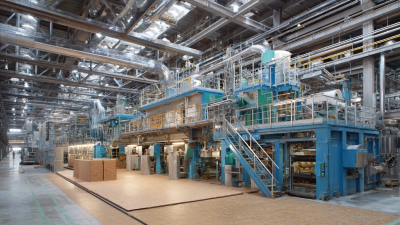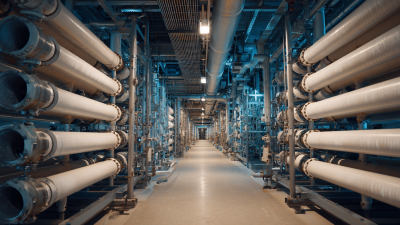Understanding the Science Behind Ultrapure Water Purification Systems: Breaking Down 99.9999% Purity and Its Applications
In recent years, the demand for ultrapure water purification systems has surged across various industries, driven by stringent quality standards and the need for enhanced operational efficiency. According to a report by MarketsandMarkets, the ultrapure water market is projected to reach USD 10.88 billion by 2025, growing at a CAGR of 8.10% from 2020. This growth is primarily fueled by applications in the semiconductor manufacturing, pharmaceutical production, and power generation sectors, where water purity levels of 99.9999% are critical to ensuring product quality and process reliability.

Understanding the underlying science of these purification systems not only offers insights into their advanced technologies but also highlights their pivotal role in supporting innovation and sustainability in demanding industries. As we explore the intricate mechanisms behind ultrapure water purification, we can better appreciate its transformative impact and essential applications across the global landscape.
Basics of Ultrapure Water: Defining Purity Levels and Importance
Ultrapure water (UPW) is defined as water with a purity level of 99.9999%, which means it contains less than 1 part per million of impurities. This extreme level of purity is essential in industries such as semiconductor manufacturing, pharmaceuticals, and biotechnology, where even trace contaminants can significantly affect product quality and performance. According to the Semiconductor Industry Association, the demand for ultrapure water in semiconductor fabrication is projected to grow at a CAGR of 5.4% to reach over 300 million gallons per day by 2025, underscoring its critical role in advanced manufacturing processes.
The importance of ultrapure water cannot be overstated, as it serves various applications beyond industrial uses. In pharmaceutical production, UPW is crucial for ensuring the safety and efficacy of drug formulations. The United States Pharmacopeia sets stringent requirements for water quality, mandating that water used in the manufacture of drugs must meet certain purity standards to prevent contamination and guarantee therapeutic effectiveness. A 2022 market report by Research and Markets highlights that the global ultrapure water market is expected to reach $6.3 billion by 2026, driven by increasing regulatory pressures and technological advancements in purification systems. This trend reflects the growing recognition of ultrapure water as a foundational element for compliance and innovation in multiple sectors.
Key Technologies in Ultrapure Water Purification Systems
Ultrapure water purification systems are essential in various industries, including pharmaceuticals, semiconductor manufacturing, and power generation. Achieving a purity level of 99.9999% necessitates a combination of advanced technologies that effectively remove contaminants, ensuring the highest quality of water for sensitive applications. One prominent technology utilized in ultrapure water systems is reverse osmosis (RO), which uses a semi-permeable membrane to eliminate ions, larger molecules, and impurities from the water. This process is often followed by deionization (DI), which further purifies the water by exchanging ions from the water with hydrogen and hydroxide ions, resulting in ultra-pure water.
Another key technology is ultrafiltration (UF), which provides a barrier to bacteria and larger particulate matter. This method can be integrated into purification processes to enhance the removal of contaminants before they reach the RO membrane, thereby protecting the system and extending its lifespan. Additionally, advanced oxidation processes (AOPs) can be employed to tackle organic pollutants and trace contaminants effectively. Together, these technologies create a multi-barrier approach that ensures the production of ultrapure water, crucial for applications where even minute impurities can lead to significant quality and safety issues.
Process Breakdown: Steps to Achieve 99.9999% Water Purity
Achieving 99.9999% purity in ultrapure water requires a meticulous and multi-step purification process. The journey begins with an initial filtration phase, where large particulates are removed through physical filtration techniques such as microfiltration or ultrafiltration. This step ensures that larger contaminants are eliminated, allowing subsequent processes to focus on smaller, more challenging impurities.
Following the initial filtration, the next step typically involves reverse osmosis (RO). In this stage, water is forced through a semipermeable membrane, which effectively removes dissolved salts, organic molecules, and a vast majority of ionic impurities. The water produced by RO is further treated through deionization, where ion exchange resins remove remaining charged particles. Finally, ultraviolet (UV) light treatment can be employed to kill any remaining microorganisms, while ensuring that the water’s quality is preserved throughout the entire process. Each of these steps is crucial in achieving the ultra-high purity required for applications in industries such as pharmaceuticals, microelectronics, and laboratory research, where even trace levels of contaminants can significantly affect outcomes.
Purification Steps Achieving 99.9999% Water Purity
Applications of Ultrapure Water in Various Industries
Ultrapure water (UPW) is critical in various industries, particularly in semiconductor manufacturing and pharmaceuticals. According to a report by MarketsandMarkets, the ultrapure water market is projected to grow from USD 4.92 billion in 2020 to USD 8.52 billion by 2025, illustrating an increasing reliance on high-purity water for production processes. In semiconductor fabrication, the purity level of 99.9999% ensures that even the smallest impurities do not compromise the quality and performance of electronic components. The use of UPW in this field not only enhances product yield but also reduces costly downtime, which can be as high as 25% of production costs.
In the pharmaceutical industry, ultrapure water is essential for meeting stringent regulations set by organizations like the FDA and the European Medicines Agency. These bodies require that water used in the manufacturing of injectable drugs must meet USP (United States Pharmacopeia) standards for purity. A study published in the Journal of Pharmaceutical Sciences highlighted that using UPW can minimize the risks of contamination and non-compliance, ultimately safeguarding patient health. Moreover, with the growing trend of biologics and personalized medicine, the demand for high-quality water sources is more critical than ever. As industries continue to evolve, the role of ultrapure water will only expand, driving innovations and stringent quality assurance measures across the board.
Challenges and Innovations in Ultrapure Water Filtration Techniques
The pursuit of ultrapure water filtration technologies faces significant challenges, particularly in the context of growing industrial demand. Sectors such as semiconductor manufacturing, pharmaceuticals, and the food and beverage industry increasingly require water purities exceeding 99.9999%. Innovations such as membrane technologies and advanced nanomaterial applications are reshaping the landscape, offering solutions that can meet these stringent specifications. Recent advancements, including the use of polyurethane nanofiber membranes, provide high strength and porosity, enhancing filtration efficiency and effectiveness in removing contaminants.
Moreover, addressing persistent pollutants like PFAS (per- and polyfluoroalkyl substances) has prompted further innovation in purification techniques. Emerging cold plasma technology shows promise in remediating these harmful substances, reflecting a proactive approach in tackling environmental concerns while focusing on sustainable management practices. Projects emphasizing water recycling, backed by funding initiatives, indicate a shift towards more sustainable practices in industries reliant on ultrapure water. These developments underscore the dynamic interplay between innovation and the pressing need for effective water filtration solutions in a rapidly evolving industrial landscape.
Understanding the Science Behind Ultrapure Water Purification Systems: Breaking Down 99.9999% Purity and Its Applications - Challenges and Innovations in Ultrapure Water Filtration Techniques
| Parameter | Value | Measurement Unit | Application |
|---|---|---|---|
| Purity Level | 99.9999% | Percentage | Semiconductor Manufacturing |
| Total Organic Carbon (TOC) | <0.5 | ppb | Laboratory Use |
| Conductivity | 0.055 | µS/cm | Pharmaceutical Manufacturing |
| Microbial Contamination | None Detected | CFU/mL | Microelectronics |
| End Use | Research & Development | N/A | Aerospace |
Related Posts
-

How to Optimize Cross Flow Filtration for Maximum Efficiency in Industrial Applications
-

Why the Future of Paper Pulp Production Relies on Sustainable Practices and Innovative Technologies
-

What is the Future of Microfiltration Membrane Technology in Global Water Treatment
-

Innovative Solutions for Optimizing Pulp and Paper Production Efficiency
-

Comprehensive Guide to Microfiltration Membrane Technology: Key Applications and Performance Insights
-

Emerging Trends in Molded Pulp Solutions at the 138th Canton Fair 2025